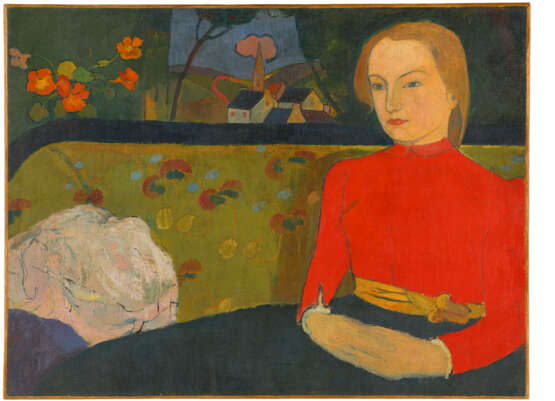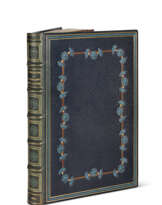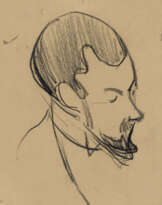ID 1051696
Лот 109 | Armand Seguin (1869-1904)
Оценочная стоимость
€ 350 000 – 550 000
Femme au corsage rouge sur un canapé
huile sur toile
72.9 x 97 cm.
Peint vers 1895-96
oil on canvas
28 ¾ x 38 1⁄8 in.
Painted circa 1895-96
Provenance
Roderic O'Conor, France et Irlande; (probablement) sa vente, Me Bellier, Paris, 6 février 1956, lot 161 (attribué à Paul Sérusier).
Galerie E. David et M. Garnier, Paris.
Myron Chapro, États-Unis (acquis auprès de celle-ci le 27 juin 1987).
Sam Josefowitz, Pully (probablement acquis auprès de celui-ci).
Puis par descendance aux propriétaires actuels.
Exhibited
(probablement) Paris, Le Barc de Boutteville, Douxième exposition des peintres impressionnistes et symbolistes, juillet 1896, no. 100 (titré 'Femme assise').
Pont-Aven, Musée de Pont-Aven, Kenavo Monsieur Gauguin, juin-septembre 2003, p. 96, no. 40 (illustré en couleurs, p. 15 et 97).
Further details
« Qu’il me suffise d’avertir le visiteur que Seguin est avant tout un cérébral – je ne dis pas, certes, un “littéraire” - qu’il exprime non ce qu’il voit mais ce qu’il pense par une originale harmonie de lignes, par un dessin curieusement compris dans l’arabesque. »
Paul Gauguin, préface de l’exposition Armand Seguin, galerie Le Barc de Boutteville, Paris, février-mars 1895.
“Qu’il me suffise d’avertir le visiteur que Seguin est avant tout un cérébral – je ne dis pas, certes, un “littéraire” - qu’il exprime non ce qu’il voit mais ce qu’il pense par une originale harmonie de lignes, par un dessin curieusement compris dans l’arabesque.”
Paul Gauguin, préface de l’exposition Armand Seguin, galerie Le Barc de Boutteville, Paris, février-mars 1895.
Le Parisien Armand Seguin, né en 1869, rencontre Paul Sérusier par l’intermédiaire de son ami Henri-Gabriel Ibels et intègre au printemps 1889 le groupe des Nabis, mais ses activités seront limitées. La visite de l’Exposition impressionniste et synthétiste au Café des Arts de l’Exposition universelle en juin 1889 le marque fortement. La découverte des œuvres de Paul Gauguin et d’Émile Bernard l’incite à partir pour Pont-Aven en avril 1891. Il y devient l’un des pivots de la colonie de peintres, se liant en particulier avec l’Irlandais Roderic O’Conor qui deviendra son plus fidèle ami.
Le style de Seguin a évolué rapidement passant d’un impressionnisme tempéré à un synthétisme affirmé, fait d’aplats colorés aux formes simplifiées comme le montre ce portrait avec une composition innovante, décentrée et déstructurée, avec le noir de la jupe, le rouge du corsage et le blanc d’un tissu. Mais ce passionné d’esthétique, avide de discussions sur l’art, par ailleurs organisateur d’expositions et critique d’art, produit peu de peintures, se consacrant pour l’essentiel à la gravure. Son œuvre gravé est remarquable et constitue l’un des points forts de l’École de Pont-Aven.
Durant l’été 1894, au Pouldu puis à Pont-Aven, il est le plus proche de Gauguin qui l’encourage. Celui-ci lui préface son exposition personnelle organisée à la galerie Le Barc de Boutteville à Paris au printemps 1895. Il s’agit de la seule préface que Gauguin, connu comme avare en compliments, consacre à un peintre. Durant l’année suivante, 1896, probablement celle de ce portrait, Seguin poursuit sa carrière, bénéficiant de quelques appuis et participant aux expositions «impressionnistes et synthétistes» de la galerie Le Barc de Boutteville aux côtés des Post-Impressionnistes et Nabis
La femme représentée sur cette peinture n’a pas été formellement identifiée. On a pensé un temps qu’il s’agissait de Madeleine Bernard, mais celle-ci n’a jamais rencontré Seguin, ni lors de sa seule venue à Pont-Aven en 1888, ni les années suivantes avant qu’elle ne quitte définitivement la France courant 1892. Cette œuvre probablement de commande et réalisée dans l’atelier de la rue Lepic à Paris est à comparer avec le portrait de Gabrielle Vien (1893, Paris, Musée d’Orsay), une commande de Charles Morrice, beau-père de la jeune fille. Suivant le même principe, les deux tableaux sont
construits autour d’un canapé sur lequel est assise la modèle, disposé devant une fenêtre ouvrant sur un paysage. Une composition florale est également présente dans les deux toiles. Les toits d’ardoise des maisons, la forme du clocher et les collines environnantes ont pu faire penser à Pont-Aven, mais il n’en est rien. Il s’agit très probablement d’un paysage imaginaire inspiré par les séjours bretons du peintre. On ne sait si ce paysage contribue au symbolisme de l’évocation, tel un rêve pour cette femme qui semble absente. La toile n’est pas signée, comme celle d’Orsay, peut-être abandonnée par le peintre dans son atelier ou jamais récupérée par son commanditaire. Peu après l’avoir peinte, Seguin est confronté à de nombreuses difficultés de santé et financières qui vont le conduire à une vie errante. Les dernières années qui le mènent à Châteauneuf-du-Faou près de Sérusier sont très difficiles. Seguin y meurt en 1903 à l’âge de 34 ans.
Ce n’est qu’en février 1956 lors de la vente de la succession de la collection O’Conor que l’œuvre réapparait au grand jour à l’Hôtel Drouot à Paris. A-t-elle été achetée par le peintre irlandais pour aider son ami ? Ou bien retrouvée après sa mort, peut-être auprès du frère de Seguin ? O’Conor est décédé en 1940 et l’histoire de cette œuvre a été alors oubliée. Les organisateurs de cette vente ignoraient la peinture de Seguin et ont rapproché cette toile de l’art de Paul Sérusier en raison des aplats simplifiés et peut-être du paysage faisant penser à la Bretagne. Par chance, elle a retrouvé aujourd’hui son identité et prend sa juste place dans le maigre corpus des peintures de Seguin, une quinzaine de toiles seulement. Gauguin n’a jamais oublié son jeune camarade car depuis les Marquises, dans Racontars de rapin, il mentionna Seguin parmi la quinzaine de peintres importants de son temps.
André Cariou
Conservateur en chef du patrimoine honoraire
Armand Seguin, a Parisian, born in 1869, met Paul Sérusier through his friend Henri-Gabriel Ibels and joined the Nabis group in the spring of 1889, but his activities would be limited. His visit to the Impressionist
and Synthetist Exhibition at the Café des Arts at the Universal Exhibition in June 1889 had a strong impact on him. His discovery of the works of Paul Gauguin and Émile Bernard encouraged him to travel to Pont-Aven in April 1891. There he became a pivotal figure in the colony of painters, notably forming links with the Irish artist Roderic O’Conor, who would become his most loyal friend.
Seguin’s style rapidly evolved, moving from tempered impressionism, to an assertive synthetism, composed of flat coloured areas with simplified shapes, as can be seen in this portrait, with an innovative, off-centred, and unstructured composition, with the black of the skirt, the red of the bodice, and the white of the fabric. But this lover of aesthetics, always eager to discuss art, also organised exhibitions and was an art critic, and produced very few paintings, mainly devoting himself to engraving. His engraved works are remarkable and are one of the high points of the Pont-Aven School.
In the summer of 1894, in Pouldu, and then in Pont-Aven, he was closest to Gauguin, who encouraged him, and would later preface his personal exhibition, held at the Barc de Boutteville gallery in Paris, in spring, 1895. This would be the only preface that Gauguin, known to be parsimonious with compliments, would ever devote to a painter. In the following year, 1896, likely the year of this portrait, Seguin continued his career, benefiting from some support and taking in the “ impressionist and synthetist” exhibitions at the Barc de Boutteville gallery, alongside the post-impressionists and the Nabis. The woman portrayed in this painting has not been formally identified. It was thought for some time that it was Madeleine Bernard, but she never met Seguin, neither during her single visit to Pont-Aven in 1888, nor during the following years before she permanently left France in 1892. This painting, probably commissioned and produced at his studio on Rue Lepic in Paris, can be compared with the Portrait de Gabrielle Vien (1893, Paris, Musée d’Orsay), a commission from Charles Morrice, the father-in-law of the sitter. Following the same principle, the two paintings are constructed around a sofa, on which the model is seated, set in front of a window, opening onto a landscape. A floral composition also appears in both paintings. The slate roofs of the houses,
the shape of the bell tower, and the surrounding hills may suggest Pont-Aven, but this is not in fact the case. It is most likely an imaginary landscape, inspired by the painter’s stays in Brittany. It is not known whether this landscape contributes to the symbolism of the evocation, like a dream, for this woman who appears absent. The canvas is not signed, as with that at the Musée d’Orsay, and was perhaps abandoned by the painter in his studio, or was never collected by its commissioner. Shortly after painting it, Seguin faced a number of health and financial issues, which led to him leading a wandering life. His final years, which led him to Châteauneuf-du-Faou, near Sérusier, were very difficult. Seguin died there in 1903, at the age of 34.
It was only in February 1956, at the sale of the estate of the O’Conor collection, that the work reappeared, at the Hôtel Drouot in Paris. Was it purchased by the Irish painter to help his friend? Or was it found after his death, perhaps by Seguin’s brother? O’Conor died in 1940, and the story of this painting was subsequently lost to history. The organisers of the sale were unaware of the paintings of Seguin, and compared the canvas to the art of Paul Sérusier, due to its simplified flat areas, and perhaps the landscape that is reminiscent of Brittany. Fortunately it has now retaken its identity, and finds its rightful place within the limited corpus of Seguin’s paintings, numbering only around fifteen canvases. Gauguin would never forget his young comrade, because, writing from the Marquesas islands, in Racontars de Rapin, he mentioned Seguin as being among the fifteen most important painters of his time.
André Cariou
Honorary Chief Curator
| Автор: | Арман Сеген (1869 - 1903) |
|---|---|
| Техника исполнения: | Масло на холсте |
| Жанр: | Портрет |
| Категория аукционного дома: | Картины |
| Автор: | Арман Сеген (1869 - 1903) |
|---|---|
| Техника исполнения: | Масло на холсте |
| Жанр: | Портрет |
| Категория аукционного дома: | Картины |
| Адрес торгов |
CHRISTIE'S 9 Avenue Matignon 75008 Paris Франция | ||||||||||||||
|---|---|---|---|---|---|---|---|---|---|---|---|---|---|---|---|
| Предосмотр |
| ||||||||||||||
| Телефон | +33 (0)1 40 76 85 85 | ||||||||||||||
| Факс | +33 (0)1 40 76 85 86 | ||||||||||||||
| Условия использования | Условия использования | ||||||||||||||
| Транспортировка |
Почтовая служба Курьерская служба Самовывоз | ||||||||||||||
| Способы оплаты |
Банковский перевод | ||||||||||||||
| Часы работы | Часы работы
|














